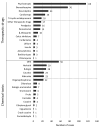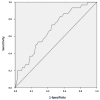Clinical and Epidemiological Characteristics of Severe Acute Adult Poisoning Cases in Martinique: Implicated Toxic Exposures and Their Outcomes
- PMID: 32283693
- PMCID: PMC7356022
- DOI: 10.3390/toxics8020028
Clinical and Epidemiological Characteristics of Severe Acute Adult Poisoning Cases in Martinique: Implicated Toxic Exposures and Their Outcomes
Abstract
The epidemiology of severe acute poisonings in the French overseas departments of the Americas remains poorly reported. The main objective of this study was to determine the epidemiology and characteristics of severe acutely poisoned adult patients.
Methods: A retrospective descriptive study was conducted from 1 January 2000 to 31 December 2010 in severely poisoned patients presenting to the emergency department (ED) of the University Hospital of Martinique, and the general public hospitals of Lamentin and Trinité.
Results: During the study period, 291 patients were admitted for severe poisoning, giving an incidence rate of 7.7 severe cases/100,000 inhabitants. The mean age was 46 ± 19 years and 166 (57%) were male. Psychiatric disorders were recorded in 143 (49.8%) patients. Simplified Acute Psychological Score (SAPS II) at admission was 39 ± 23 points and Poisoning Severity Score (PSS) was 2.7 ± 0.8 points. Death was recorded in 30 (10.3%) patients and hospital length of stay was 6 ± 7 days. The mode of intoxication was intentional self-poisoning in 87% of cases and drug overdose was recorded in 13% of cases. The toxic agent involved was a therapeutic drug in 58% and a chemical product in 52% of cases. The predominant clinical manifestations were respiratory failure (59%), hemodynamic failure (27%), neurologic failure (45%), gastrointestinal manifestations (27%), and renal failure (11%). Polypnea, shock, ventricular fibrillation or tachycardia, and gastro-intestinal disorders were the main symptoms associated with death. The main biological abnormalities associated with death in our patients were metabolic acidosis, hypokalemia, hyperlactatemia, hypocalcemia, renal injury, rhabdomyolysis, increased aspartate aminotransferases, and thrombocytopenia. Extracorporal membrane oxygenation (ECMO) was used in three patients and specific antidotes were used in 21% of patients.
Conclusions: Acute poisonings remain a major public health problem in Martinique with different epidemiological characteristics to those in mainland France, with a high incidence of poisoning by rural and household toxins.
Keywords: Martinique; acute poisonings; epidemiology; intensive care unit.
Conflict of interest statement
The authors declare no conflicts of interest.
Figures




References
-
- Mégarbane B., Donetti L., Blanc T., Chéron G., Jacobs F. Intoxications graves par médicaments et substances illicites en réanimation. Reanimation. 2006;5:332–342. doi: 10.1016/j.reaurg.2006.07.006. - DOI
-
- Burillo-Putze G., Munne P., Dueñas A., Pinillos M.A., Naveiro J.M., Cobo J., Alonso J., The Clinical Toxicology Working Group. Spanish Society of Emergency Medicine (SEMESTOX) National multicentre study of acute intoxication in emergency departments of Spain. Eur. J. Emerg. Med. 2003;10:101–104. doi: 10.1097/00063110-200306000-00006. - DOI - PubMed
LinkOut - more resources
Full Text Sources

